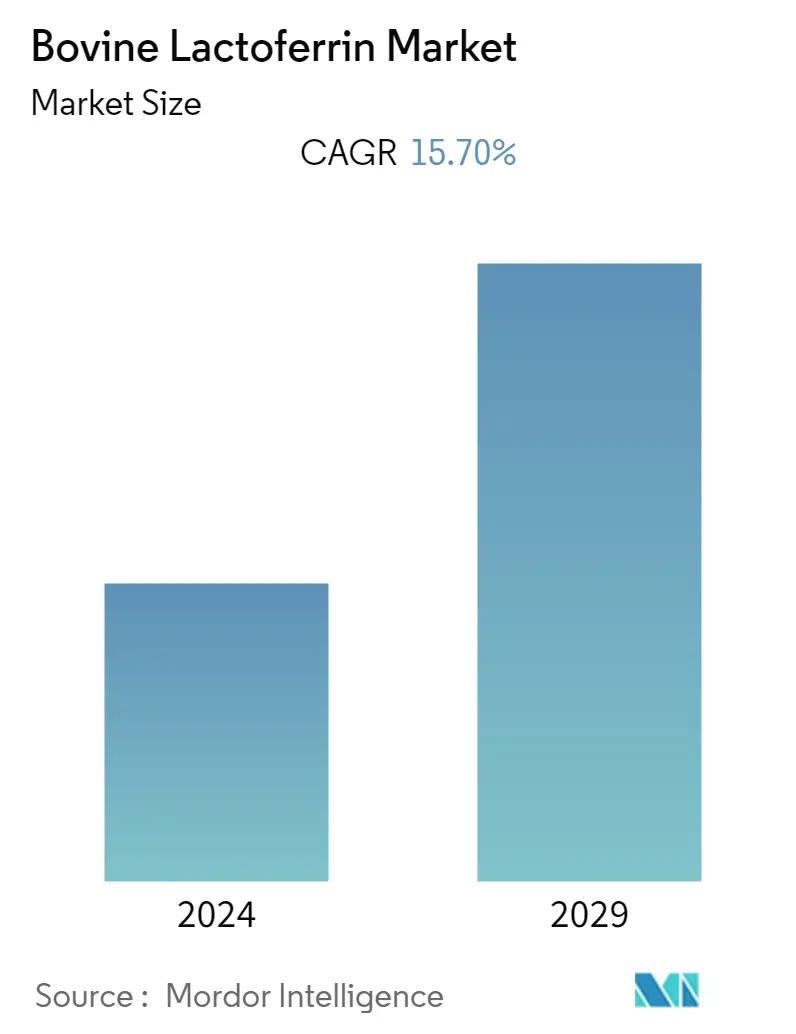Market Size of Bovine Lactoferrin Industry

| Study Period | 2019 - 2029 |
| Base Year For Estimation | 2023 |
| CAGR | 15.70 % |
| Fastest Growing Market | Asia-Pacific |
| Largest Market | North America |
| Market Concentration | High |
Major Players
*Disclaimer: Major Players sorted in no particular order |
Need a report that reflects how COVID-19 has impacted this market and its growth?
Bovine Lactoferrin Market Analysis
The Bovine Lactoferrin Market is projected to register a CAGR of 15.7% during the forecast period.
The COVID-19 pandemic had a moderate impact on the bovine lactoferrin market. The increasing count of patient number diagnosed with the SARS-COV-2 virus fueled the economic burden around the globe. This huge patient population was raising the demand for available treatment options during the pandemic. In response to this, a large number of research and development activities were going on for the effectiveness of lactoferrin for the treatment of COVID-19. According to a study published by National Center for Biotechnology Information (NCBI) in October 2021, it was reported that owing to the in vitro antiviral activity of bovine lactoferrin, it can significantly decrease the effect of the virus in mild to moderate COVID-19 patients. Also, according to a research study published by NCBI in February 2021, it was reported that lactoferrin proved to be effective against the growth of multiple common human coronaviruses, including HCoV-OC43, HCoV-NL63, and HCoV-229E. Apart from these studies, several clinical trials have also been conducted to identify the efficacy of bovine lactoferrin for the treatment of COVID-19 patients. For instance, a study published by ClinicalTrial.gov aimed to assess the potential of apolactoferrin to reduce the mortality and morbidity rate in COVID-19 patients. This resulted in a significant rise in the adoption of bovine lactoferrin-based products such as nutraceuticals, infant formulas, and others during the pandemic.
An increasing number of working women around the globe, along with the increasing application of bovine lactoferrin in infant formula, is supporting the growth of the market during the study period. Additionally, rising initiatives of the major players to increase the production capacity of bovine lactoferrin are also anticipated to cater to the growing demand for lactoferrin in the pharmaceutical and nutraceutical industries and foster the growth of the market.
Certain clinical benefits of bovine lactoferrin, including anti-cancer, anti-infective, and anti-inflammatory effects, widen the application area of bovine lactoferrin in a number of industries, including infant formula, pharmaceuticals, and nutraceuticals, among others. For instance, according to an article published by Armor Proteines in September 2022, it was reported that due to the anti-microbial property of bovine lactoferrin, it binds with iron and prevents the growth of pathogenic bacteria in infants.
Also, it was reported that it boosts the activity of leukocytes and helps in the defense mechanism of the body. The above-mentioned factors are some of the sole reasons for the increasing use of bovine lactoferrin in infant formula. For instance, according to Good Health New Zealand, one of their product, Modified Milk Powder with added lactoferrin, provides immune support ad supports good health for infants. Also, Mead Johnson & Company, LLC., one of the leading companies in infant formula, claimed added nutritious value with immune boosting capacity for its Enfamil Enspire infant formula.
Additionally, increasing the production capacity of lactoferrin by the key players is another factor attributing to the higher adoption of lactoferrin among the general population and supporting the growth of the market. For instance, according to a press release by FrieslandCampina DOMO in September 2020, it was reported that they increased their production capacity of lactoferrin by 600% from 10 metric tons to 70 metric tons. This caters to the rising demand for lactoferrin among different industries.
Further, the increasing number of working women worldwide is resulting in a decreasing rate of breastfeeding. For instance, according to an article published by the Office of National Statistics in July 2022, it was reported that the number of working women reached 15.7 million in the United Kingdom in 2022, which is a jump of 2 million in the last ten years. According to data from Organisation for Economic Co-operation and Development (OECD), it was reported that the average percentage of women in the working-age population increased from 61.16% in Q1 2019 to 62.36 in Q3 2022 for the OECD countries. Also, according to an article published by Keeping-Mum in August 2021, it was reported that the breastfeeding rate is significantly low in the United Kingdom. This is alternatively fostering the demand for infant formula and subsequently fueling the application of lactoferrin in the infant formula for added nutritional value.
Thus, owing to the aforementioned factors, the market is anticipated to grow at a lucrative growth rate during the forecast period. However, certain side effects, including allergic reactions and diarrhea, are limiting the adoption rate of lactoferrin and lactoferrin-added products during the study period.

